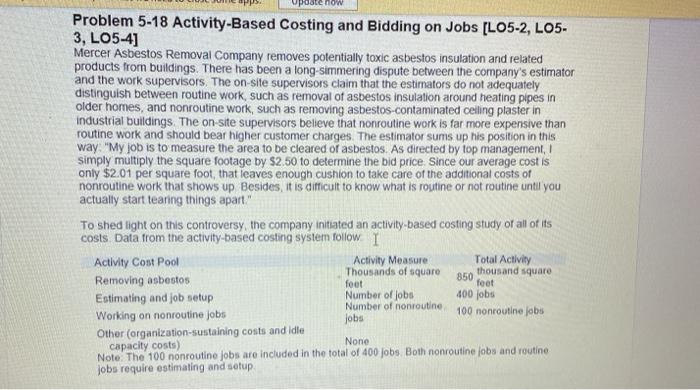Problem 5-16 Comparing Traditional and Activity-Based Product Margins [LO5-1, L05-3, L05-4, L05-5] Hi-Tek Manufacturing, Inc., makes two types of industrial component parts--the B300 and the T500. An absorption costing income statement for the most recent period is shown: Hi-Tek Manufacturing Inc. Income Statement Sales 1,774,500 Cost of goods sold 1.235,631 Gross margin 538,869 Selling and administrative expenses 630,000 Net operating loss $ (91,131) Hi-Tek produced and sold 60,500 units of B300 at a price of $21 per unit and 12,600 units of T500 at a price of $40 per unit. The company's traditional cost systeln allocates manufacturing overhead to products using a plantwide overhead rate and direct labor dollars as the allocation base. Additional information relating to the company's two product lines is shown below. Direct materials Direct labor Manufacturing overhead Cost of goods sold B300 T500 $ 401,000 $ 162,400 $ $ 120,500 $ 43,000 Total 563,400 163,500 508,731 1,235,631 $ The company has created an activity-based costing system to evaluate the profitability of its products Hi-Tek's ABC implementation team concluded that $57,000 and $102,000 of the company's advertising expenses could be directly traced to B300 and T500, respectively. The remainder of the selling and administrative expenses was organization-sustaining in nature. The ABC team also distributed the company's manufacturing overhead to four activities as shown below The company has created an activity-based costing system to evaluate the profitability of its products. Hi-Tek's ABC implementation team concluded that $57,000 and $102,000 of the company's advertising expenses could be directly traced to B300 and T500, respectively. The remainder of the selling and administrative expenses was organization-sustaining in nature. The ABC team also distributed the company's manufacturing overhead to four activities as shown below Manufacturing Activity Activity Cost Pool (and Activity Measure) Overhead B300 T500 Total Machining (machine-hours) $ 203,091 90,000 62,700 152,700 Setups (setup hours) 145, 140 74 280 354 Product-sustaining (number of products) 100,400 1 1 2 Other (organization-sustaining costs) 60,100 NA NA NA Total manufacturing overhead cost $ 508,731 Required I 1. Compute the product margins for the B300 and T500 under the company's traditional costing system 2 Compute the product margins for B300 and T500 under the activity-based costing system 3. Prepare a quantitative comparison of the traditional and activity-based cost assignments now Problem 5-18 Activity-Based Costing and Bidding on Jobs (L05-2, LO5- 3, L05-4] Mercer Asbestos Removal Company removes potentially toxic asbestos insulation and related products from buildings. There has been a long-simmering dispute between the company's estimator and the work supervisors. The on-site supervisors claim that the estimators do not adequately distinguish between routine work, such as removal of asbestos insulation around heating pipes in older homes, and nonroutine work, such as removing asbestos-contaminated celling plaster in industrial buildings. The on-site supervisors believe that nonroutine work is far more expensive than routine work and should bear higher customer charges. The estimator sums up his position in this way: "My job is to measure the area to be cleared or asbestos. As directed by top management, simply multiply the square footage by $2.50 to determine the bid price. Since our average cost is only $2.01 per square foot, that leaves enough cushion to take care of the additional costs of nonroutine work that shows up Besides, it is difficult to know what is routine or not routine until you actually start tearing things apart": To shed light on this controversy, the company initiated an activity-based costing study of all of its costs Data from the activity-based costing system follow I Activity Cost Pool Activity Measure Total Activity Thousands of square thousand square 850 Removing asbestos feet Estimating and job setup Number of Jobs 400 jobs Number of honroutine 100 nonroutine jobs Working on nonroutine jobs Jobs Other (organization-sustaining costs and idle capacity costs) Note: The 100 nonroutine jobs are included in the total of 400 jobs. Both nonroutine jobs and routine Jobs require estimating and sotup foot None Costs for the Year Wages and salaries 308,000 Disposal fees 706,000 Equipment depreciation 90.000 On-site supplies 50,000 Office expenses 210.000 Licensing and insurance_410.000 Total cost $1,774,000 Distribution of Resource Consumption Across Activities Removing Estimating and Job Working on Nonroutine Asbestos Setup Jobs Other Total Wages and salaries 60% 10% I 20% 10% 100% Disposal fees 70% 0% 30% 0% 100% Equipment depreciation 40% 5% 25% 30% 100% On-site supplies 70% 20% 10% 0% 100% Office expenses 15% 35% 20% 30% 100% Licensing and 25% 0% 50% 25% 100% Insurance Required: 1. Perform the first-stage allocation of costs to the activity cost pools. 2. Compute the activity rates for the activity cost pools. 3. Using the activity rates you have computed, determine the total cost and the average cost per thousand square feet of each of the following jobs according to the activity-based costing system. a. A routine 1,000-square-foot asbestos removal job. b. A routine 2,000-square-foot asbestos removal job. C. A nonroutine 2,000-square-foot asbestos removal job











